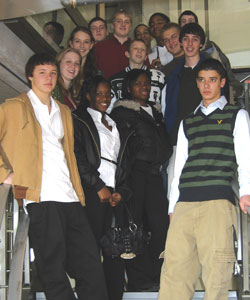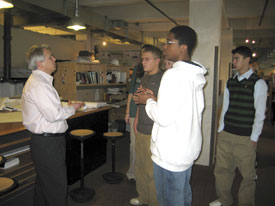Leading the Way for Future Engineers

We will create dynamic partnerships with our nation’s schools to prepare an increasing and more diverse group of students to be successful in science, engineering and engineering technology.
That is the mission of Project Lead the Way (PLTW), a national program meant to raise awareness and interest in the field of engineering for junior high and high school students. Here in Peoria, District 150 has teamed up with several area companies to begin educating students in this field before they even decide on a college or major.
Through strategic partnerships—such as the ones between PSA-Dewberry and Richwoods High School, and Caterpillar, Inc. and Woodruff High School, among others—students are able to learn more about what the engineering field really consists of. According to the Project’s website, pltw.org, the “formula for success is simple. It’s all about building strategic partnerships among middle schools, high schools, colleges and universities, and business and industry to provide students with the rigorous, relevant, reality-based knowledge necessary to pursue engineering or engineering technology programs in college. Partnering with PLTW is easy, and the ongoing support and professional development ensure success.”
According to Ray Lees, principal at PSA-Dewberry, one of the main problems our society will face in the near-future is a shortage of engineers. Bruce Hay of Volt Workforce Solutions confirms this: “At present, the local demand for engineering talent exceeds the amount of locally available talent.” But this doesn’t have to set us back if we can engage young students in the field early on. Many junior high and high school students are unsure what engineering is really about and do not know that there are several sub-specialties within the larger field. Informing young students is the first step of the process PLTW has begun.
Project Lead the Way focuses on math and science, making these subjects relevant for students. “By engaging in hands-on, real-world projects, students understand how the skills they are learning in the classroom can be applied in everyday life,” according to pltw.org. Long-term projects, collaborating with classmates and using multi-disciplinary skills—everything from math and science to language arts—to solve complex problems all prepare students for technical fields such as engineering.
Richwoods Goes to PSA-Dewberry
During a recent field trip to the offices of PSA-Dewberry, students in Richwoods’ Project Lead the Way class had the opportunity to see and speak with certified architects and engineers who design everything from heating ducts and plumbing to structural supports and building facades. Mechanical Engineering Group Leader Chuck Bartee, PE, LEED AP, told students about his journey to becoming an engineer. He credited his early interest in the Etch-a-Sketch, good math and science grades, and success in college engineering courses with his eventual career as an engineer. “I didn’t just wake up one day and decide to be a mechanical engineer. It was a process,” Bartee explained.
Blake Gleason, PE, a newly-certified mechanical engineer at PSA-Dewberry, discussed his professional responsibilities, what engineers do on a day-to-day basis and answered students’ questions on how to take the first steps toward beginning a career in engineering.
Introduction to Engineering Design
The students currently enrolled in the Introduction to Engineering Design (IED) class at Richwoods High School are guinea pigs, so to speak; this is the first year that Project Lead the Way courses have been offered at the District 150 high school. According to their teacher, Anne Hart, about 25 students initially signed up for the class. After learning that was an early-bird class, which began (and ended) before first period, however, ten of them were no longer interested, leaving a manageable class of 15 dedicated students.
These dedicated students needed a dedicated teacher, and Hart stepped up to the plate. She attended an intense two-week training period through the University of Illinois in the summer in order to be qualified to teach Richwoods’ PLTW class. That alone does not qualify a teacher, however; Hart must continue her education in this discipline via virtual training throughout the entire school year.
When the IED class began in the fall, students focused on basic drafting skills and learning the Inventor software they would use for the entire course. Once equipped with these basic skills, projects began, and class became much more fun.
“The class is a great way for students to see all the disciplines interacting together—math, science, art, etc.—to see how it’s all practical to life,” Hart noted. “It also allows them to see the connection and meaning for why they go to school, which becomes motivation.” As most of us know from experience, motivating and interesting high school students in coursework is half the battle.
IED allows students to complete tasks based on their motivation levels. Students are given minimum requirements to be completed by certain dates, but they can work as much and as fast as they wish. Hart said some students are more motivated than others, and the pace at which they work concretely shows where they fall in the whole spectrum.
According to Hart, the greatest benefit of the class is the idea that students can problem-solve—something which can help in whatever field they ultimately decide to go into. Seeing the practicality of problems they face now gives them a better glimpse of “real life.” Learning that not all answers can be found in books is something that all students eventually learn, and the hope is that learning this lesson early will greatly benefit the future engineers of America.
Next year, Introduction to Engineering Design will be open to freshmen who are taking geometry concurrently, as District 150 works to better implement the program they began experimentally this year.
The Students’ Perspective
When weighing the pros and cons of the PLTW program, student Megan Frager said that, because the program is so new, her teacher is learning along with the students and doesn’t know the answers to every question they have. This isn’t a bad thing, though, as students teach themselves in some ways and learn the importance of collaboration and asking each other for help—something required by both college and the “real world.”
One clear benefit of the class, according to student Rebecca Epping, is that “we get to see the different sides of engineering and use the [computer] programs before getting to college.” This, she said, is very helpful in terms of deciding a college major. Both girls have been involved in several pre-engineering and technology courses at Illinois Central College, Bradley STEPS and Caterpillar’s Destination Technology.
Another classmate, Omar Elhouar, is the son of Souhail Elhouar, an engineering professor at Bradley University who is also a consultant for PSA-Dewberry. Professor Elhouar sees the tremendous benefits of the class for his son, who is interested in designing cars. He said that the fact that these students are learning to use engineering software while still in high school is a big step in the right direction. While he learned basic drafting skills in high school, it wasn’t until after he became a professor that he learned how to use engineering software like AutoCad.
Replenishing Engineers in Peoria
Elhouar suggested that the PLTW program will help bring Peorians back to Peoria after earning engineering degrees in college. “When those kids are involved with a local place [such as PSA-Dewberry or Caterpillar], it will have an effect on them when they graduate. The involvement of local companies and firms is great, especially for establishing that kind of willingness to stay and work here in Peoria.”
For many in the engineering field, it is important that Peoria invest in future engineers from central Illinois. Lees said that we as a community “have a vested interest in not only starting the Project Lead the Way program, but making sure it keeps going.” We need Peoria-area high school students who go on to earn engineering degrees in college to come back to their hometown to begin their careers.
Hay noted, “Developing talent organically and keeping Peorians and other central Illinois natives in the community where they grew up is an important part of the recipe to long-term community growth and success. While newcomers are always welcome and add their own special talents and diversity mix, there is something unique about home-grown talent and its special contribution to a true sense of community. In truth, they know the community and they can easily relate to its people. They are familiar with what approaches and methods work and those that do not work.” By investing in current junior high and high school students with Project Lead the Way, it is hoped that Peoria’s pool of engineers can be easily replenished. IBI

